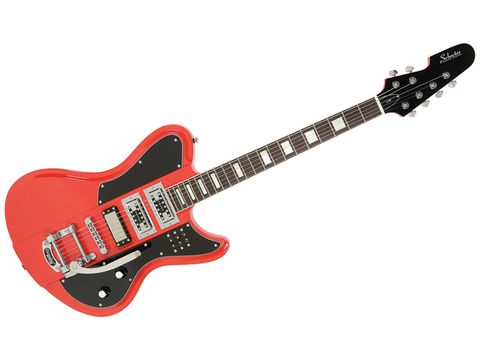Let's dream for a minute. You're the long-term guitarist in Nine Inch Nails and also the man who was once tasked with replacing Slash in Guns N' Roses. Your signature guitar, then, is going to be a weapon.
Perhaps a scythe body shape? Active pickups to slice through a wall of pounding electronics? Possibly a Floyd to ensure you return to pitch after those erratic scoops?
"The glassy feel makes string bends a dream."
Well, Robin Finck is that guitarist, but his surprisingly retro-looking Schecter shows these stereotypes the door. The outline comes from the Schecter Ultra.
Unlike the standard Ultra models, Finck has gone with a reverse-style headstock with a 2/4 machinehead arrangement.
Pickup-wise, there's a pair of Duncan Designed FG101 mini- humbuckers in the neck and middle pickup positions and a Seymour Duncan SM-3B in the bridge. Finck has also opted for a genuine Bigsby B-50 vibrato.
The body is big and the large headstock takes this guitar almost to Firebird-sized proportions. While the arrangement of the machineheads could be the source of some annoyance, it's strangely intuitive and pretty soon you'll forget that it's any different.
The rosewood fingerboard has 22 extra jumbo frets, which are finished impeccably, and the glassy feel makes string bends and wide vibrato a dream. Our model came set up with a comfortable string height - not the lowest, but definitely not the highest action we've played.
Finck's guitar has a three-position toggle for each pickup and all can be set to either 'full', 'split' or 'off'. Played clean, the neck presents you with an authentic surfy twang.
The middle pickup is less round and you get greater attack with more thump from the mids. It sounds great for a straight-up rock rhythm tone under distortion, too.
The bridge SM3 gives the most output and bite, and if you've doubted mini-humbuckers' hard-rock credentials, this might make you re-evaluate.
The most fun comes when you mix the combinations - all pickups on, middle and neck together, neck in full humbucking mode with the bridge split, for example.
There's something here for everyone (bar extreme metal) and it's hard not to be impressed. However, the size could be a problem if you struggle with big guitars and switching between radically different sounds isn't going to happen quickly.


